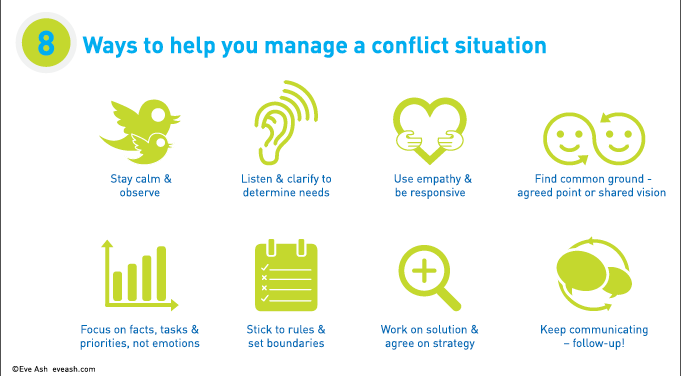We all face conflict at different times with
An angry team member
A furious customer
A fuming boss
An explosive workmate
The client from hell…
Usually we don’t get the practice we need to handle it well because
- It doesn’t happen all that often in most workplaces
- We often don’t have good role models around us – in fact we are far more likely to see conflict handled badly
- It’s often when we least expect and maybe at a problematic time – like rushing off to pick up kids or overdue on a deadline
So, here are some invaluable tips to help you manage that difficult conflict.
1. Stay calm & observe
Don’t get tripped up by the other person’s bad behaviour. Behave rationally. Be calm – in fact be a model others will follow. Don’t take it personally; it’s usually not about you. You may be end of a chain of frustrations for this person. Never attack or get defensive.
Rise above the bad behaviour and observe and focus on how “they” are behaving, like a scientist observing animal behaviour or a psychologist meeting a client. This is NOT how you are feeling or how crazy this is, so don’t focus on how this is making you feel. Sometimes a break or change of location can make a difference. Take time out – have a coffee together. Remember, this will be over soon enough… so don’t get dragged down to a bad place yourself.
2. Listen and clarify to determine needs
Look, listen and find out why they are angry and upset. Ask them what is wrong.
Try to understand what they may have been going through. If they are angry with you try to get clarity on the differences between you. I’d like to make sure I understand…
Use an effective mix of open and closed questions. Probe but make sure you are not threatening.
What pressures are they under? Ask and find out.
What is most important for them? What is urgent? What are their priorities?
3. Use empathy & be responsive
3 Helpful A’s – Appreciate, Acknowledge, Apologise.
Listen, care and acknowledge – regularly summarise what has been said.
Know how to acknowledge feelings and apologize if needed.
I can hear how upset you are. I realise how annoyed you are.
I’m sorry you are so upset. I can see why you are angry.
Let’s work out the best way forward… I want to make sure we work out a solution.
Be aware of cultural and other differences – respect different points of view.
Take responsibility as a possible contributor: Maybe I wasn’t clear… Maybe I made it hard for you to …
Apologising and acknowledging helps reduce anger and stops a conflict spiral escalating.
So seek to understand and be empathic – as best you can.
4. Find common ground – agreed point or shared vision
Present a clear picture of key issues.
Let’s try and work out what you need and how close we are to getting there…
Let’s work out what’s working and what we are OK with…
Let’s see what we agree on/ what is OK and start from there…
Seek a strong starting point – discuss the agreed position
React positively to constructive comments. Be honest.
Be clear and assertive about own position. Clarify expectations and shared points.
5. Focus on facts, tasks and priorities, not emotions
Establish facts, concerns and prioritise. Keep moving forward.
Limit the venting and focus on the future, not the past.
Be calm and assertive, not aggressive.
6. Stick to rules and set boundaries
Clarify boundaries – be clear about rules. Considera second opinion.
Show tolerance when things are ambiguous and there are grey areas.
7. Work on solution and agree on strategy
Most people want action. Agree on way forward, and put in writing if appropriate.
Take responsibility “I will find out and call you back in an hour”. And do exactly that or earlier, never later.
Consider whether others can assist. Explain what is being done.
Use a logical approach – maybe stepped agreements.
8. Keep communicating – follow-up!
Show interest and care, make sure no one is stuck
Provide useful information. Keep channels open. Summarise the outcomes.
Check in at a later stage.
Maybe also need to …
- Take person aside– give feedback – or refer them for help
- Especially if you work with them – explain and give examples
- Debrief your stress
- Find one person you respect; limit the amount of “download” time. Don’t over-talk it.
- Document exactly what happened- facts in writing.
- Report bullying and get advice from HR

